Which should schools prioritise for the future of work? How should this be done?
How many parents or schools exercise patience to teach children the right typing posture and finger placement/movement just as they do for handwriting and other academic/life concepts? Is this one of those skills that we leave our children to develop on their own?
At the beginning of life, children are guided to develop their physical and mental muscles using various activities. The outcome of these activities help the child to build capacity for the next level of achievement. Handwriting is one of the achievements that children build their fine motor muscles to gain and having a good HANDWRITING is very helpful for children for various reasons.
Benefits of proper handwriting for children in preschool and primary school
- Development of eye, mind and hand coordination: The process of forming letters correctly and consistently by a child involves seeing a picture of the desired letter and trying to replicate that letter in the nicest possible way. You find children writing, and erasing letters or words to correct by themselves only because the letters written did not come out well or the letters of the word, as we say, are not sitting nicely on the line. Children begin to create mental image (in the mind) of how they want their words to look, they coordinate their hands to form what’s in their mind and their eyes vet the outcome. Developing a coordination of these senses by age 5-6 is paramount and beneficial for use in other aspects of life.
- Development of independence in achieving tasks: Teachers and parents have so much to teach children. 99% of the time, the children must have the opportunity to execute/practise on their own. I see children get frustrated and cry just because they are not able to spell or write their thoughts out on paper. A particular boy in my church asks for his Dad whenever its time to write and digging deeper into it, our team realised that he is struggling with expressing his comprehension answers in writing. Now he has enrolled on our tutoring programme to learn and gain confidence with this skill.
- Development of coordination between thought and expression: Children are advised to process their thoughts mentally or out loud before they express it in writing . This is not always the case especially as they begin to experience speed drills in school and among friends. Writing by hand slows them down just enough to achieve clarity and accuracy while expressing their ideas in the expected time frame.
- Development of functional Brain activities: In a research carried out by Karin H. James, and Laura Engelhard showed evidence of the brain development during handwriting vs typewriting. In the research, “preliterate, five-year old children printed, typed, or traced letters and shapes, then were shown images of these stimuli while undergoing functional MRI scanning. A previously documented “reading circuit” was recruited during letter perception only after handwriting—not after typing or tracing experience. These findings demonstrate that handwriting is important for the early recruitment in letter processing of brain regions known to underlie successful reading. Handwriting therefore may facilitate reading acquisition in young children”. read more here
- Development of cognitive processes such as memory retention, comprehension, and information processing: the research above further explains this point.
- Definition of their own personality: With practise and corrections and tweaks during handwriting activities, children build a sense of self through mental notes of how their writing comes out, what they like about it and what they’d like to change. Overtime, they see that they cannot help further changes and they stick to the latest result. This reflects a view of themselves. A fulfilling factor will be that they were guided to create the best visual outcomes of themselves in their writing before there could be no more tweaks to it.
With innovation and future workplace readiness in mind, typewriting has become an increasingly in-demand need and gaining priority in conversations as a skill that children need to learn earlier than later in schools and homes. As important as this skill is for older children, we passively direct the children at it without getting them to learn the discipline that it promotes, as listed below
- Right body posture.
- Mental speed that comes with correct use of finger placement.
- Multitasking – their ability to read and type and correct all at the same time.
- Boost of confidence in the use of digital tools and technology.
- Preparing children for higher efficiency in future work life.
- Efficiency in digital communication.
- Learning life long skills.
Knowing this, and seeing the future that we are preparing our children for, parents and schools must strategically ensure that there is a cohesive transition from teaching handwriting to teaching typewriting. This can be implemented seamlessly either as a study space promotion where they move from pencil to pen to devices for their notes or as an expectation for a certain age.
PS: Setting this as an incentive or an extra challenge for excellent work presents the idea as a source of motivation and the children will achieve this even before the given deadline. Education really needs some exciting changes.

